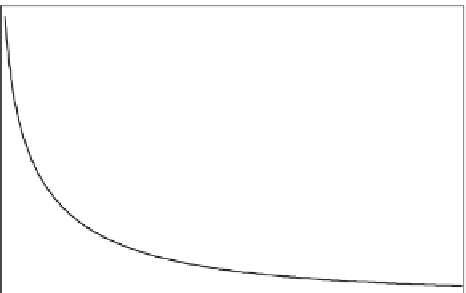Geoscience Reference
In-Depth Information
2
1 . 5
t
p +
1
0 . 5
0
1
1 . 5
2
2 . 5
3
P
+
Fig. 9.16 Scaled time to ponding
t
p
+
=
(
k
0
/
A
0
)
2
t
p
against scaled rainfall rate
P
+
=
(
P
/
k
0
); the rainfall rate is
assumed to be constant during the rainfall event. The heavy line represents the solution obtained by
the quasi-steady state approach, i.e. Equation (9.89) with
α
p
=
0
.
50 (Parlange and Smith, 1976); the
thin line is the relationship recommended by Broadbridge and White (1987) for field soils whose
hydraulic properties are not well known, i.e. Equation (9.89) with
α
p
=
0
.
55.
D
w
behavior is typical for repacked soils in the laboratory and for undisturbed field soils
at greater depth, which have little secondary structure. However, as illustrated in Figure
9.8, this is not always the case for the diffusivity
D
w
of undisturbed field soils near the
surface, where secondary structure may affect the hydraulic characteristics. Broadbridge
and White (1987) analyzed the performance of several approximate expressions for
t
p
by comparing them with the results of an exact solution for a special functional form
of
k
(
). They concluded that among them Equation (9.87) of Parlange and
Smith (1976), or Equation (9.89) with
θ
) and
D
w
(
θ
50, is indeed quite accurate for soils with
a structure similar to that of repacked soils; they also found that Equation (9.89) can
be made to describe the time to ponding for most soils with a different structure by
adjusting the constant
α
p
=
0
.
α
p
within a range between 0.50 and 0.66. For field soils, whose
hydraulic properties are unknown, they recommended the use of (9.89), and they felt that
α
p
=
0
.
55 would be a reasonable choice which would result in errors of at most
±
10%.
Equation (9.89) with
α
p
=
0
.
55 is also illustrated in Figure 9.16.
9.4.3
Infiltration after the start of ponding: time compression approximation
Prior to the time of ponding, the precipitated water can readily enter into the soil, and
the rate of infiltration is equal to the precipitation rate, as indicated by the second of
Equations (9.5). Once ponding starts, the soil surface is satiated, that is
θ
=
θ
0
, so that
the boundary condition at
z
0 becomes the third of (9.5), which is the same as the
second of (9.62) for the infiltration capacity problem. However, the initial condition at the
=






































































